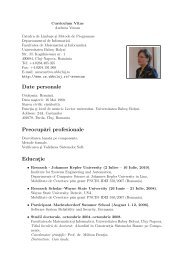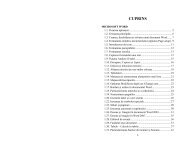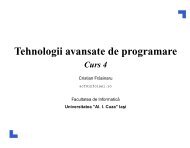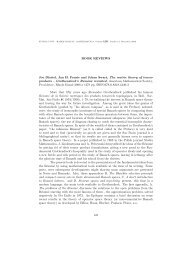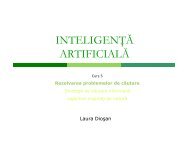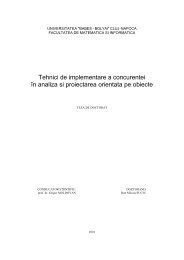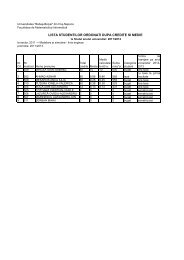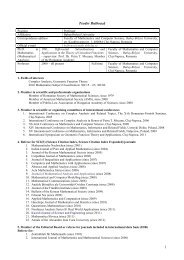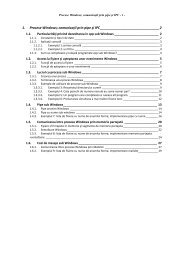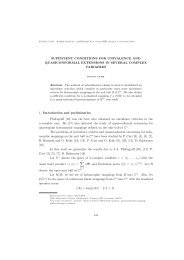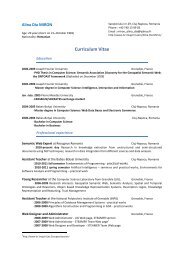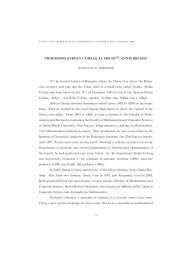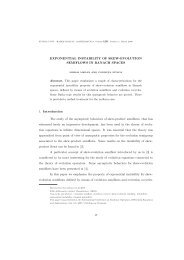CONTENTS
CONTENTS
CONTENTS
You also want an ePaper? Increase the reach of your titles
YUMPU automatically turns print PDFs into web optimized ePapers that Google loves.
232 MIHAIELA LUPEA (1)<br />
form d = α:β<br />
γ , where: α is called prerequisite, β is called justification and γ is called<br />
consequent. A default d = α:β<br />
γ can be applied and thus derive γ if α is believed and<br />
”it is consistent to assumed β”(meaning that ¬β is not believed).<br />
From all versions of default logics, constrained default logic has the most desirable<br />
formal properties: supraclassicality, semi-monotonicity, commitment to assumptions,<br />
due to the global consistency condition for the applied defaults.<br />
Definition 2.2.[4] Let D be a set of defaults. The set of residues and the set<br />
of justifications of D with respect to a set C of formulas are defined as follows:<br />
ResC D =<br />
<br />
α α:β<br />
γ | γ ∈ D, C ∪ {β, γ} ⇒ false ,<br />
Justif C D =<br />
<br />
β| α:β<br />
<br />
γ ∈ D, C ∪ {β, γ} ⇒ false .<br />
The residues corresponding to the applied defaults are monotonic rules and are<br />
used to reduce the nonmonotonic reasoning process modelled by constrained default<br />
logic into a monotonic one according to the following theorem based on a theorem<br />
from [4].<br />
Theorem 2.1. Let ∆ = (D, W ) be a default theory. (E, C) is a constrained<br />
extension of ∆ if E = T hres (W, ResC D ), C = T h(T hres (W, ResC D ) ∪ Justif C D ), where<br />
T h(·) is the classical consequence operator and T hres (·, R) is the consequence operator<br />
of the predicate formal system enhanced with the set R of residues.<br />
E is the actual extension embedded in the reasoning context C. We remark that<br />
the nonmonotonic reasoning process modelled by constrained default logic is guided<br />
by a maximal consistent reasoning context.<br />
3. Sequent and anti-sequent calculi for residues<br />
The two complementary systems: sequent and anti-sequent calculi [1] for classical<br />
logics are enhanced with specific rules for residues [1, 5] preserving the soundness and<br />
completness of the new axiomatic systems. We use the same metasymbols ⇒ and ⇒<br />
to express the inference relations in classical sequent/anti-sequent calculi and in the<br />
corresponding systems, enhanced with residues.<br />
Sequent rules for residues: Anti-sequent rules for residues:<br />
(Re1) Γ⇒Ψ<br />
Γ, α<br />
γ ⇒Ψ Γ⇒α Γ,γ⇒Ψ<br />
(Re2) Γ, α<br />
γ ⇒Ψ Γ⇒α Γ⇒Ψ<br />
(Re3) Γ, α<br />
γ ⇒Ψ<br />
(Re4) Γ,γ⇒Ψ<br />
Γ, α<br />
γ ⇒Ψ<br />
4. Axiomatization of skeptical reasoning in constrained logic<br />
Definition 4.1. Let ∆ = (D, W ) be a default theory. A skeptical constrained<br />
default sequent has the syntax: Constr; (W, D); Res ↦−→ U. The set U of formulas is<br />
called succedent. The antecedent contains Constr(a set of constraints expressed using<br />
the modalities: M and L), the default theory (W, D) and Res (the set of residues<br />
corresponding to the applied defaults).



